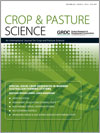In low-rainfall environments, a high frequency of cereal crops has been favoured for optimising productivity and risk. However, cereals at high intensity often lead to declining water-use efficiency and increasing inputs to cope with emergent nutritional, disease and weed problems. The value of including breaks in the cropping sequence can involve a high level of uncertainty in low-rainfall areas where non-cereal crops are more risky and profitability is largely determined by the subsequent benefit to cereal productivity. In this study, we aimed to improve understanding of the magnitude and primary source of break benefits such as nutrition, water and disease management in a low-rainfall environment where a high level of within-field soil variability can also contribute to uncertainty about the value of breaks. In on-farm field experiments near Karoonda in the South Australian Mallee, breaks were grown in 2009 or 2010 on four distinct soil types across a dune–swale catena. The effect of these breaks on subsequent cereal production was measured for up to 3 years. In addition, the effect of breaks on nutrition and water available, along with disease infection in subsequent cereal crops, was explored and actual yields were compared with nitrogen and water-limited potential yields. Consistent cumulative benefits to subsequent cereal crops of at least 1 t ha–1 after 3 years accrue from breaks grown on the different soil types. The inclusion of breaks had beneficial effects on the cycling and supply of nutrients along with some short-term impacts on infection by Rhizoctonia solani AG8 in subsequent cereals, whereas there were no conclusive effects of breaks on the supply of water to subsequent crops. This study suggests that the inclusion of both legume and brassica breaks is likely to be beneficial to subsequent cereal production where nitrogen is a factor limiting productivity in low-rainfall, semi-arid environments.
How to translate text using browser tools
28 April 2015
Break-crop effects on wheat production across soils and seasons in a semi-arid environment
T. M. McBeath,
V. V. S. R. Gupta,
R. S. Llewellyn,
C. W. Davoren,
A. M. Whitbread
ACCESS THE FULL ARTICLE

Crop and Pasture Science
Vol. 66 • No. 6
May 2015
Vol. 66 • No. 6
May 2015
N mineralisation
N supply potential
rotation
sequence




